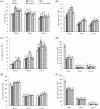Effects of foliar application of salicylic acid and nitric oxide in alleviating iron deficiency induced chlorosis of Arachis hypogaea L
- PMID: 28510913
- PMCID: PMC5432746
- DOI: 10.1186/1999-3110-55-9
Effects of foliar application of salicylic acid and nitric oxide in alleviating iron deficiency induced chlorosis of Arachis hypogaea L
Abstract
Background: The aim of this experiment was to analyze the alleviation mechanism of exogenous salicylic acid (SA) and sodium nitroprusside (SNP, a nitric oxide donor) on peanut seedlings under Fe deficiency. The effects of SA and SNP on iron uptake and availability, ions balance and oxidant damage were studied with foliar application of exogenous 1.0 mM SA (SA) or 2.5 mM SNP (SNP) or 0.5 mM SA+1.25 mM SNP [1/2(SA+SNP)] or 1.0 mM SA+2.5 mM SNP (SA+SNP).
Results: The results showed that after 21 days treatment, the peanut seedlings growing under iron deficiency conditions exhibited leaf interveinal chlorosis, and this iron-deficiency induced symptom was prevented by foliar application of SA, SNP, 1/2 (SA+SNP), especially SA+SNP. The increased contents of chlorophyll and active iron, and increased Fe accumulation in cell organelles were observed in SA+SNP treated young leaves, suggesting that an improvement of iron availability in plants. Moreover, the improved nutrient solution pH, increased H+-ATPase activity and increased iron concentration in roots in SA+SNP treated plants, suggesting that SA+SNP is effective in modulating iron uptake. Furthermore, the increased calcium (Ca), magnesium (Mg) and zinc (Zn) concentrations and decreased manganese (Mn) and copper (Cu) concentrations in the leaves and roots of peanut indicated that SA+SNP stimulated the maintenance of ions disturbed by Fe deficiency. In addition, SA+SNP alleviated the increased accumulation of superoxide anion (O2•-) generation rate and malondialdehyde (MDA), and modulated the antioxidant enzymes.
Conclusions: These results indicated that the interaction of SA and SNP promoted Fe uptake, translocation and activation; modulated the balance of mineral elements; and protected Fe deficiency induced oxidative stress. Therefore, SA and SNP had synergistic effects in alleviating chlorosis induced by Fe deficiency.
Keywords: Active iron; Antioxidant enzymes; Arachis hypogaea L.; Mineral elements; SA; SNP.
Figures



Similar articles
-
The mechanism of hydrogen sulfide mitigation of iron deficiency-induced chlorosis in strawberry (Fragaria × ananassa) plants.Protoplasma. 2019 Mar;256(2):371-382. doi: 10.1007/s00709-018-1298-x. Epub 2018 Aug 29. Protoplasma. 2019. PMID: 30159606
-
[Effects of sodium nitroprusside on growth and physiological characteristics of tomato seedlings under iron deficiency and NO3- stress].Ying Yong Sheng Tai Xue Bao. 2017 Apr 18;28(4):1246-1254. doi: 10.13287/j.1001-9332.201704.015. Ying Yong Sheng Tai Xue Bao. 2017. PMID: 29741322 Chinese.
-
Interactive effects of Salicylic acid and nitric oxide in alleviating zinc toxicity of Safflower (Carthamus tinctorius L.).Ecotoxicology. 2017 Aug;26(6):752-761. doi: 10.1007/s10646-017-1806-3. Epub 2017 Apr 20. Ecotoxicology. 2017. PMID: 28429184
-
Exogenous sodium nitroprusside and glutathione alleviate copper toxicity by reducing copper uptake and oxidative damage in rice (Oryza sativa L.) seedlings.Protoplasma. 2014 Nov;251(6):1373-86. doi: 10.1007/s00709-014-0639-7. Epub 2014 Apr 22. Protoplasma. 2014. PMID: 24752795
-
A Critical Review of Methodologies for Evaluating Iron Fertilizers Based on Iron Reduction and Uptake by Strategy I Plants.Plants (Basel). 2024 Mar 13;13(6):819. doi: 10.3390/plants13060819. Plants (Basel). 2024. PMID: 38592963 Free PMC article. Review.
Cited by
-
Resveratrol improves the iron deficiency adaptation of Malus baccata seedlings by regulating iron absorption.BMC Plant Biol. 2021 Sep 23;21(1):433. doi: 10.1186/s12870-021-03215-y. BMC Plant Biol. 2021. PMID: 34556040 Free PMC article.
-
Genomics of Metal Stress-Mediated Signalling and Plant Adaptive Responses in Reference to Phytohormones.Curr Genomics. 2017 Dec;18(6):512-522. doi: 10.2174/1389202918666170608093327. Curr Genomics. 2017. PMID: 29204080 Free PMC article. Review.
-
Alleviation of iron deficiency in pear by ammonium nitrate and nitric oxide.BMC Plant Biol. 2022 Sep 12;22(1):434. doi: 10.1186/s12870-022-03826-z. BMC Plant Biol. 2022. PMID: 36089596 Free PMC article.
-
Nitric Oxide Alleviates Salt Stress Inhibited Photosynthetic Performance by Interacting with Sulfur Assimilation in Mustard.Front Plant Sci. 2016 Apr 25;7:521. doi: 10.3389/fpls.2016.00521. eCollection 2016. Front Plant Sci. 2016. PMID: 27200007 Free PMC article.
-
TaCIPK19-3D Improves Photosynthetic Machinery, Growth, Yield, and Salt Tolerance in Transgenic Rice.Rice (N Y). 2025 Jul 16;18(1):67. doi: 10.1186/s12284-025-00827-y. Rice (N Y). 2025. PMID: 40668260 Free PMC article.
References
-
- Briskin DP, Leonard RT, Hodges TK. Isolation of the plasma membrane: markers and general principles. Method Enzymol. 1987;148:542–558. doi: 10.1016/0076-6879(87)48053-1. - DOI
-
- Buchanan BB, Gruissem W, Jones RL. Biochemistry and Molecular Biology of Plants. Rockville, MD: American Society of Plant Physiologists; 2000.
LinkOut - more resources
Full Text Sources
Other Literature Sources

